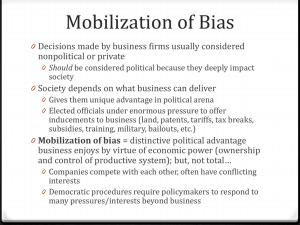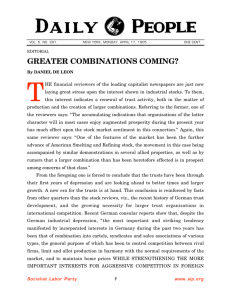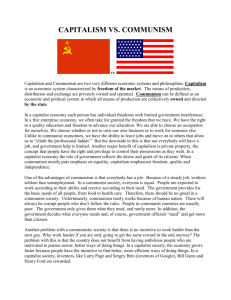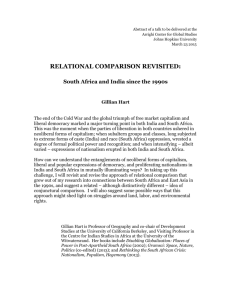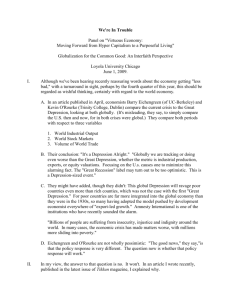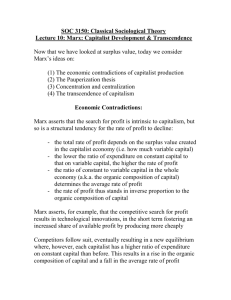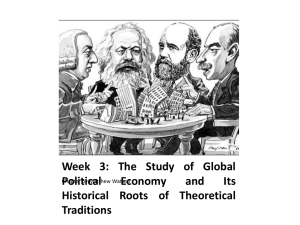Structural Crises in the Historical Dynamics of Social
advertisement
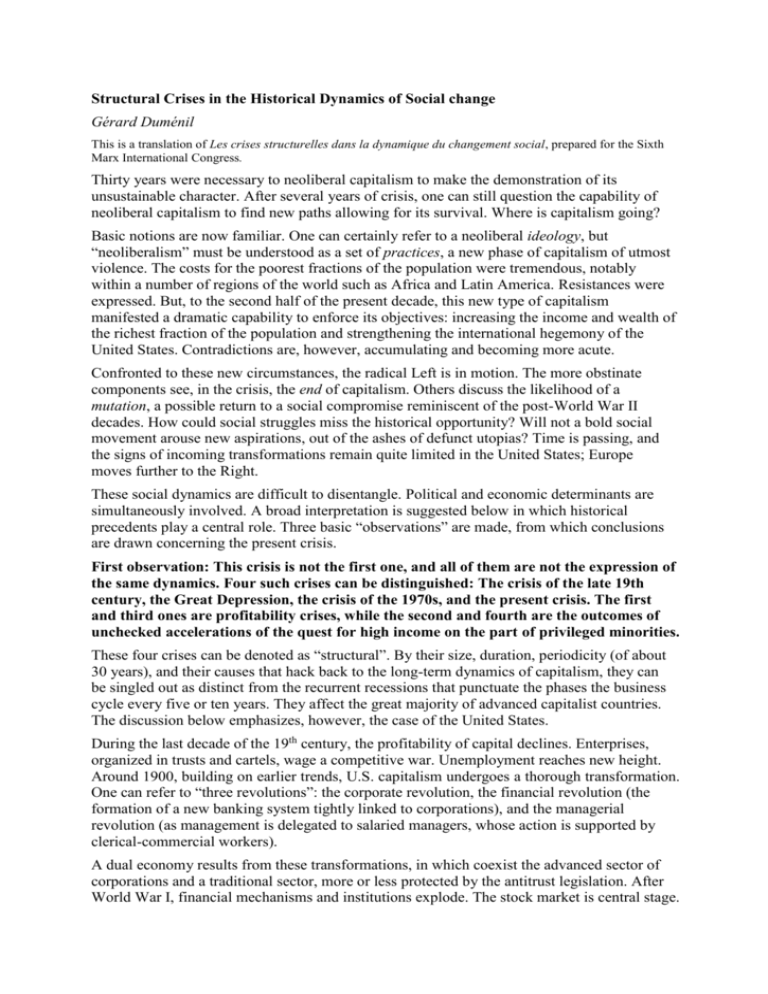
Structural Crises in the Historical Dynamics of Social change Gérard Duménil This is a translation of Les crises structurelles dans la dynamique du changement social, prepared for the Sixth Marx International Congress. Thirty years were necessary to neoliberal capitalism to make the demonstration of its unsustainable character. After several years of crisis, one can still question the capability of neoliberal capitalism to find new paths allowing for its survival. Where is capitalism going? Basic notions are now familiar. One can certainly refer to a neoliberal ideology, but “neoliberalism” must be understood as a set of practices, a new phase of capitalism of utmost violence. The costs for the poorest fractions of the population were tremendous, notably within a number of regions of the world such as Africa and Latin America. Resistances were expressed. But, to the second half of the present decade, this new type of capitalism manifested a dramatic capability to enforce its objectives: increasing the income and wealth of the richest fraction of the population and strengthening the international hegemony of the United States. Contradictions are, however, accumulating and becoming more acute. Confronted to these new circumstances, the radical Left is in motion. The more obstinate components see, in the crisis, the end of capitalism. Others discuss the likelihood of a mutation, a possible return to a social compromise reminiscent of the post-World War II decades. How could social struggles miss the historical opportunity? Will not a bold social movement arouse new aspirations, out of the ashes of defunct utopias? Time is passing, and the signs of incoming transformations remain quite limited in the United States; Europe moves further to the Right. These social dynamics are difficult to disentangle. Political and economic determinants are simultaneously involved. A broad interpretation is suggested below in which historical precedents play a central role. Three basic “observations” are made, from which conclusions are drawn concerning the present crisis. First observation: This crisis is not the first one, and all of them are not the expression of the same dynamics. Four such crises can be distinguished: The crisis of the late 19th century, the Great Depression, the crisis of the 1970s, and the present crisis. The first and third ones are profitability crises, while the second and fourth are the outcomes of unchecked accelerations of the quest for high income on the part of privileged minorities. These four crises can be denoted as “structural”. By their size, duration, periodicity (of about 30 years), and their causes that hack back to the long-term dynamics of capitalism, they can be singled out as distinct from the recurrent recessions that punctuate the phases the business cycle every five or ten years. They affect the great majority of advanced capitalist countries. The discussion below emphasizes, however, the case of the United States. During the last decade of the 19th century, the profitability of capital declines. Enterprises, organized in trusts and cartels, wage a competitive war. Unemployment reaches new height. Around 1900, building on earlier trends, U.S. capitalism undergoes a thorough transformation. One can refer to “three revolutions”: the corporate revolution, the financial revolution (the formation of a new banking system tightly linked to corporations), and the managerial revolution (as management is delegated to salaried managers, whose action is supported by clerical-commercial workers). A dual economy results from these transformations, in which coexist the advanced sector of corporations and a traditional sector, more or less protected by the antitrust legislation. After World War I, financial mechanisms and institutions explode. The stock market is central stage. The profit rate rises slowly, but the U.S. economy enters into a Great Depression, while the urgently required policies are not implemented. The traditional sector of the economy falls and the banking system enters into a deep crisis. Both the New Deal and World War II will be necessary to ensure the recovery. But capitalism is metamorphosed. The new crisis comes thirty years later. The technical and institutional innovations of the early 20th century have gradually transformed most sectors of the economy: from manufacturing industries, to services and trade. The gains are not lost, but the movement forward comes to a halt. Despite policies of stimulation, important income transfers to the benefit of enterprises and the diminished weight of taxation on enterprises, the profit rate declines from the late 1960s to the 1970s. Capital accumulation slows down and inflation becomes cumulative. Unemployment soars. The structural crisis of the 1970s creates the conditions for the establishment of a new social order. In the wake of a major financial crisis during the 1980s, neoliberalism initiates a new trajectory. The entire economy is reoriented to the benefit of high incomes. The tools are a new corporate governance, new policies, deregulation, in particular, internationally, the opening of trade borders and the free movements of capital. Conditions favorable to the rise of profit rates are created. Profits are, however, not conserved by enterprises to the benefit of investment, but paid out as high wages and income to capital holders. The financial craze reaches the entire globe. The present crisis is the outcome of the convergence of such trends, in particular in the United States, in combination to the unsustainable trajectory of disequilibria of the U.S. economy, whose continuation was made possible by the globalization under U.S. hegemony. More than a financial crisis, it is a crisis of neoliberalism, of globalization, and the expression of the unsustainable character of the trajectory of the U.S. economy in its real and financial components. Overall, two types of crises are, here, at issue. Their causes and manifestations are clearly distinct. The first and third are in line with Marx’s analysis of the recurrent tendency for the profit rate to fall; the other two crises, are reminiscent of the conflagrations to which Marx referred in the Manifesto, where the capitalist apprentice sorcerer loses control of the forces he stimulated. In the first instance, capitalism “sink”; in the second, it “explodes”. Second observation: Each of the phases that separate such crises manifests the prevalence of distinct social configurations, denoted as « social orders », in which both politics and economics are involved. They are the expression of the domination of given classes or fractions of classes, and of the compromises on which these dominations are based. The list of such social orders is: the first financial hegemony, the social compromise of the first decades following World War II, and the second financial hegemony in neoliberalism. “Finance” refers here to capitalist classes and their financial institutions. Between four large crises, three spaces are created for distinct social orders. The first phase stretches from the end of the 1890s to the Great Depression. In the wake of the crisis of the late 19th century, the United States progressed, with a considerable advance over other countries, along the path opened by the three revolutions that marked the establishment of “modern capitalism”, reaching new degrees of efficiency. Besides traditional middle classes, the importance of the new classes of managers and clerical-commercial workers increases considerably, along a wide spectrum of functions and incomes. The direct leadership of enterprises is transferred to managers. The domination of capitalist classes—the owners of big corporations, nonfinancial as well as financial—would have been impossible if compromises had not been struck with these old and new classes. But the constraint remains quite weak. The power of capitalist classes is real. Two hegemonies are, thus, established. The first such hegemony, that of the upper fraction of capitalist classes, is social. It can be denoted as a “financial hegemony”, referring to this fraction of capitalist classes and its financial institutions, where the power of this class is concentrated, as “Finance”. The second hegemony, the leadership of the United States, is international, Wilsonian. The advance of the United States over other countries allows for this international pre-eminence independently of the constitution of a formal empire (actually, after the abandonment of this project). The second phase stretches from the beginning of the New Deal in 1933 to the end of the 1970s. The Great Depression destabilized the first financial hegemony but not the international hegemony of the United States. The foundations of the hegemony of capitalist classes are actually fragile. Broad staffs of managers have been established at the center of nonfinancial and financial enterprises, as well as in the government sector (as officials). They are in control of both organization and innovation. A clear concern exists among capitalist classes. Already, the notion of a “power outside of ownership” had been advanced, when the rentier bourgeois class could be described as a “leisure class”. These threats materialize in the New Deal. And it would certainly be necessary to mention here other experiences, such as the Popular Front. In a context of capitalist chaos, to the initiative of officials in collaboration with managers, a new ideology of organization emerged. The term in use is “planning”, and we are referring here to the United States of the New Deal and the war economy1 (or postwar France). Franklin Roosevelt establishes a new relationship with workers and takes some distance from big business. After World War II, however, the radical character of these trends is considerably diminished. The Keynesian revolution makes of the central control of the macroeconomy a duty of the Government. These policies are rather naturally combined with the new enhanced welfare state. Thus, planning yields in front of policies (to quite distinct degrees among countries). A new social order is established. It rests on a social compromise between the managerial classes and the popular classes of production and clerical-commercial workers. The prerogatives of capitalist classes—their powers and income—are considerably diminished. In a number of countries, entire sections of the productive economy, nonfinancial and financial, are nationalized; overall, the autonomy of managers in the conduct of corporations is considerably increased; policies aim at employment, growth, and the rise of productivity, in conformity with the “productivist” trends that dominate the period; the activity of the financial sector is directed toward growth. The compromise with popular classes is expressed in the progress of purchasing powers, social protection, and the progress of education. There is an overall strong faith in “progress”, both social and technical (while ecological equilibria are destroyed). These transformations are typical of the countries of the Center—in the context of an unchecked continuation of imperialist trends, despite ambitious development policies as in Latin America and Asia. Neoliberal capitalism defines a third phase, from the beginning of the 1980s to present days. Taking advantage of the tensions created during the crisis of the 1970s, capitalist classes imposed a “second financial hegemony”, aiming at re-establishing and broadening of their prerogatives. The compromise between managerial and popular classes is gradually disarticulated, beginning with the upper fraction of managerial hierarchies (top executives). But the adhesion of managers to neoliberal strategies spreads progressively, testifying to the irreversible reversal. The United States leads this movement, but other countries follow suit, within various configurations, whose caricatural example is Russia. But this reversal of alliances will, with a small lag, also affect the French society, which could have been immune after decades of state intervention and powerful social movement. 1 One can read the famous The Road to Serfdom, that von Hayek published in 1944. Third observation: Structural crises manifest the convulsions resulting from deeper movements, the expression of the long-term dynamics of the mode of production, like earthquakes manifest the movementsof tectonic plates. The directions of historical transformations are the combined effects of these underlying dynamics and social struggles. None of the outcomes can be separated from the momentum of struggles, simultaneously, resistances from below and the conflicts within upper classes. In the sequence of social orders, the underlying economic tendencies and the crises play fundamental roles. They create conditions; they put on the agenda new transformations (like the three revolutions at the end of the 19th century, the Keynesian revolution, and globalization); but no determinism is implied concerning outcomes. To such economic factors, one must add the dynamics of “class struggles”, the notion being taken here in a broad sense to include social tensions among the components of upper classes. The end of the 19th century and the beginning of the 20th century coincided with the rise of the worker movement. The United States are no exception to this observation. The Socialist Party of America was formed in 1901, the result of the fusion of preexisting organizations. Numerous and violent strikes occurred at the beginning of the century. 2 A number of measured aiming at some improvements of the conditions of workers were initiated, but the struggle of workers was severely repressed, in particular during World War II, in the name of patriotism. In the wake of the structural crisis of the late 19th century, a compromise was established between the two sections of capitalist classes, the owners of big corporations and those of the more modest enterprises not engaged into the new framework of the institutions of modern capitalism. But this social arrangement did not survive the Great Depression, of which it was one factor. In this context, the upper fractions of capitalist classes engaged into the transformations described earlier, the three revolutions. These developments allowed them to supersede the effects of the social and economic tensions of the period. But the new framework of capitalism also represented a threat on the hegemony of these classes in the longer run, as the establishment of the new social order after World War II, later, demonstrated. This convergence between economic and socio-political conditions was even more blatant than in the case of the Great Depression. This period coincided with a high point in the history of the worker movement, supported by the great utopia of a classless society. Revolts and utopia reinforced one another within this broad juncture of the interwar period. Two variants of historically interrelated phenomena developed in parallel. On the one hand, from within the Leninist worker movement, new classes of managers and officials (managers in a broad sense), proclaiming themselves the most consequent representatives of working masses, led the struggle to victory, under the banner of “socialism”. The cost was a strict organization of the movement and a heroic struggle. On this basis, a class of managers (not only the “bureaucrats” of a degenerated workers’ state) established itself as a new ruling class. Class struggle was, thus confiscated, forbidden (or commanded from above), to the fall of the system. On the other hand, in the social storm resulting from the depression, managers, supported by the dynamics of the worker movement, seized the helm from the hands of capitalists, without, however, jettisoning them. Thus, came to existence various variants of what can be called “social democracy”. The difference with the first, “revolutionary”, variant is that this configuration allowed for the continuation of what is now denoted as “democracy”. But the distance was large from the etymology, since the “people” is far from wielding power within class republics. Government institutions reflected the features proper to the social 2 Notably, the famous Ludlow Massacre in 1916. compromise of which they were the agent. This later modality gave to the experience its human face. From the viewpoint of the underlying social forces and the class hierarchies that would result, the two trajectories were the outcome of the same dynamics. In both cases, two broad historical currents converged: on the one hand, the revolt of exploited classes and, on the other hand, the great organizing project inherent in the social nature of managers. Marxism was a result of this encounter. The fate of the first variant is well known, the true grave-digger of utopias. As for the path opened by the “postwar social compromise”, its progress was, finally, blocked by capitalist classes in the neoliberal revolution. Even if the winding path of the plot differs significantly, the actors of the two big tragedies were fundamentally the sames. And the endings were finally the identical. The details of the process that marked the entrance into neoliberalism at the end of the 1970s are also typical of the convergence of the underlying economic circumstances and on-going struggles. Concerning economic trends, the new directions initiated the during the first decades following World War II had created new favorable conditions, inherited from the three revolutions of the late 19th century. They contributed, to a large extent, to the establishment and continuation of the social compromise to the Left that prevailed during these decades. They made compatible: (1) the progress of the purchasing power of the great mass of wage-earners (and welfare expenses); (2) the tremendous increase in government expenses; and (3) a high level of profitability of enterprises, whose profits contributed to finance public expenses and, for the remaining fraction, were retained by corporations for investment. The relationship of these mechanisms with struggles is easily understood. When these advances came to a halt, the social forces underlying the compromise were not able to organize themselves to push the endeavor even one step further—given the overall context of the “death of utopias” resulting from the failure of the other path (within so-called socialist countries). The obsessive preoccupation for the stimulation of the macroeconomy by wages, misplaced in a profitability crisis and the desire to be part of the broad dynamic of globalization on the part of the upper fractions of managers destabilized the compromise, and deprived the movement of its political content. Capitalist classes, struggling from the origin of their set back, successfully confronted resistances, repressed strikes, and imposed a new social order, rallying, without too much difficulty, managers to their cause. New ideology and politics were imposed, wrapped up as the “third way”, a tragic farce, hiding the swing to the Right, a new social compromise to the top. The French Socialist Party provides a telling example of these new directions. Back to the present crisis: In the absence of a powerful popular movement, the new social order that will follow the crisis will primarily reflect the tensions prevailing within upper classes. Again, its main field will be the relationship between ownership and “management” in a broad sense, as a manifestation of broad historical dynamics. The international rivalry among countries, whose economies are now placed in a situation of direct competition, will, however, have a major impact on these movements. Crises do not stop the path of history; they accelerate its movement, as in the old metaphor of the role of violence in the maieutic of history. But setting aside the “old” to the benefit of the “new”, crises determine the long-term directions of history. Despite differences in nature, the parallel between the contemporary crisis and the crisis of the late 19th century is revealing. This latter crisis did not destabilize the hegemony of capitalist classes. In combination with on-going struggles, this crisis imposed major transformations of the basic framework of capitalism to these classes. A number of specific aspects of the revolutions of the late 19th century (such as the formation of large corporations and the ascendancy of the new financial sector on these corporations) worked in favor of the consolidation of the power of the upper fractions of capitalist classes; while also contributing to the same ends, other aspects (like the delegation of management to salaried workers in the managerial revolution) also generated important threats in the longer run; finally, other urgently needed transformations were not realized, as the central management of the macroeconomy. Similar transformations are already programmed in the present crisis, and other will be devised. From the viewpoint of capitalist classes and their allies, the crisis of the 1970s provided an opportunity to promote the dramatic revolution of globalization. All workers of the world were placed in a situation of competition. Globalization put a halt to the progress of the welfare programs that earlier popular struggles had imposed. Upper classes, again, attempt to draw similar advantages from the contemporary crisis. The words of the protagonists of this endeavor are those of “austerity”, while the true nature of the move is “increased exploitation”. Concerning “causes”, it is to the Great Depression that the contemporary crisis must be first compared. The two crises followed periods of financial hegemony. The Depression accelerated the transformations initiated at the transition between the 19th and 20th century, as the three revolutions were only fully completed in the wake of World War II, when the fourth revolution, the Keynesian revolution, was only lately taking place. Concerning the basic framework of capitalism, at a deeper level of analysis, a lot was continued but, also, profound metamorphosis occurred. The strength of class struggle worldwide and the threats inherent in a utopia of radical transformation imposed the establishment of a new social order. Again, politics moved to the fore, impacting the course of history. The same could be true of the contemporary crisis. There is, in neoliberalism, a “reactionary” component—marching against the direction of history—as is manifest in the restoration of the former objectives of social and economic dynamics aiming at the exclusive benefit of capitalist classes (as in the “all for lenders and shareholders”). Confronting the “excesses” to which led these new directions, we are told that a new “discipline” is required, a new framework of “regulations”. The idea is, again, to strengthen a trajectory. There will be a cost for capitalist classes, at least within the main countries of the Center. There will be setbacks, for the best or the worst. This discipline must be understood as the requirement of a new configuration of the social relationships between capitalists and managers. The main transformations on the agenda seem to be confined to this field, at the top of social hierarchies. Contemporary social tensions and the historical transformations of the capitalist mode of production converge in the present crisis of neoliberalism, and will affect the social order “from above”. In these upper spheres of social relations, this means a new adjustment to the benefit of management. In the absence of a strong social movement on the part of popular classes, it is unlikely that this new framework will involve significant components “to the Left”. Again, the United States might open new paths. Such new directions are not yet clearly underway (only to very limited extents). But, in this country, such changes are urgently required, more than in other regions of the world. Since the beginnings of neoliberalism, the contradictions of the neoliberal social order, everywhere in the world, were becoming more acute. In the United States, however, the quest for high income on the part of upper classes converged with the disequilibria of the economy, notably its deficits and the cumulative domestic and international indebtedness of the country. Only the international hegemony of the United States, of which the dollar is the symbol and the instrument, allowed for the continuation of this trajectory during three decades. In the wake of the boom of high technologies during the second half of the 1990s, the equilibria of the U.S. are now impossible to manage. This situation is the outcome of the gradual divorce between upper classes and the country as economic territory. The dilemma is now clear: either the reconciliation occurs, or the comparative decline of the country, already under way, will undergo of process of spectacular acceleration. “Reconciliation” implies here a radical questioning of neoliberal options, given their class character. It is, therefore, the “national factor” (with the obvious risk of “nationalism”) that could become determinant in the coming years and decade. Revolts are on the agenda, but they are slow to gather momentum. A fundamental message can be drawn from Marx. In the absence of a powerful popular movement, the vehicle of a true alternative, the chances of getting rid of capitalist classes and classes in general, are quite limited. Revolt without utopia is like an arrow without target, lost for class struggle. The time for capitalist classes is passed, but they will, more and more tightly, attempt to strengthen their link to their allies of the upper fractions of managerial hierarchies, whispering to their ears the charms of sharing the participation in their capitalist’s condition of owners of the means of production.
